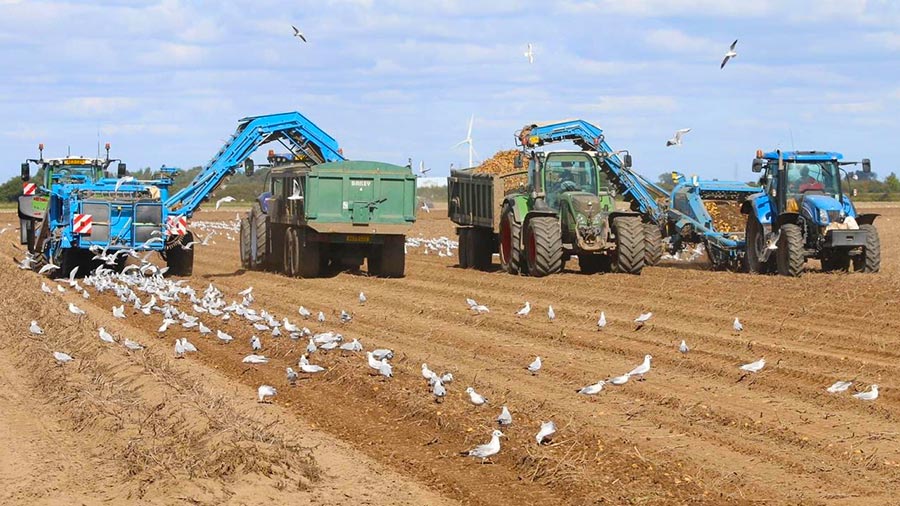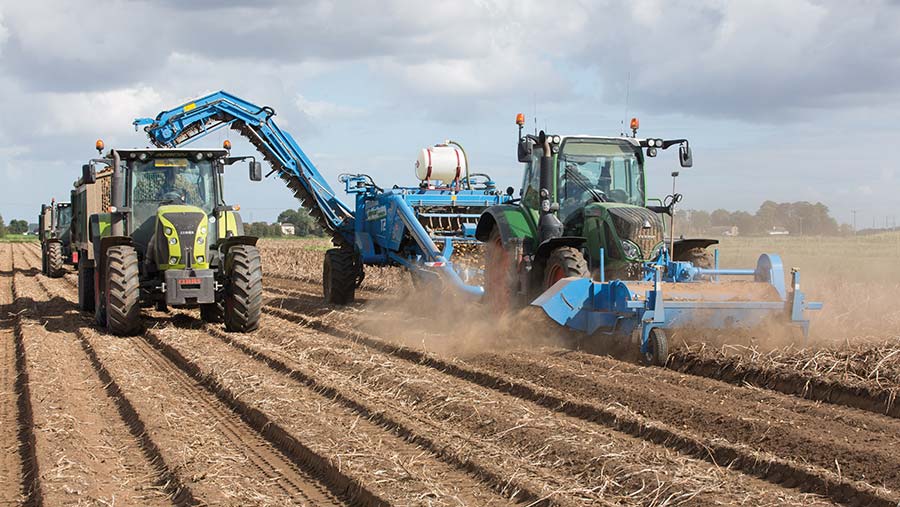Potato yields suffer in the dry with high storage costs to come
 Potato harvest at JS Means Farms near King's Lynn © Mike Means
Potato harvest at JS Means Farms near King's Lynn © Mike Means Potato yields are down significantly this season due to the hot, dry spring and early summer weather, and for growers putting spuds into cold storage there is the double whammy of higher electricity costs along with lower tuber numbers.
Thanks to lower yields, harvest is going faster than expected on Mark Means’ farm in north-west Norfolk. Lifting began on 8 September and he was 35% through by the middle of the month.
“Unirrigated potatoes usually average 55t/ha – this season we’re looking at 40t/ha and maybe a bit below,” says Mr Means of JS Means Farms, near King’s Lynn.
“Irrigated potatoes usually average 55-60t/ha, but some haven’t made 50t/ha. We would normally expect 50% of the crop to be bakers, but we are seeing about 30% – and some as low as 10-15%,” he adds.
See also: Offsetting produces UK’s first carbon-neutral potatoes
Lower area in Norfolk
Mr Means is growing 110ha of potatoes for the pre-pack market on his silty loam land, down 40ha on last year.
He mainly grows varieties such as Melody, Mozart, Lanorma, King Edward and others specific to particular supermarkets.
Lanorma and King Edward haven’t liked the drought, even with irrigation, and dry matters were higher than normal at 22-24%.
“The scary part is storage – we are losing money storing potatoes. The cost of electricity was about £21-22/t for long-term storage on the farm last year,” he says
This season, before the government announced the new electricity discount for businesses, prices had reached £82/t – an annual cost of £120,000.
“If the store was empty, we would have some solar and wind-generated electricity that we could sell to the grid for the equivalent of £40/t,” he adds.

© Tim Scrivener
Even following the official announcement, electricity costs will still be £20/t up on his old contract, and after March 2023 the new discounts could end. The farm stores potatoes until June/July when it will have to cope with higher ambient temperatures.
As well as electricity, other costs such as fuel, agrochemicals, fertilisers and seed are making potato growing financially unsustainable, warns Mr Means, and he plans to grow less than 80ha in 2023 because of the increased risk.
“We try to farm sustainably, but if we end up importing potatoes into the UK there will be a higher carbon cost and skills will be lost that won’t come back,” he says.
Cornish crop
Further south, the potato harvest started in mid-July with crisping varieties. Processing varieties have only just got under way, with lifting likely to last until late October, says Jeremy Oatey of Agricola Growers in south-east Cornwall, where about 75% of the crop cannot be irrigated.
“On this unirrigated land we are seeing massive variation, so much greater than in a normal year, and we are seeing yields from 27t/ha to 37t/ha,” he says.
“It has been the heat as much as the dryness. The well-bodied fields and those that have had muck have hung in there better than fields which didn’t.
“Also, fields closer to the sea have done better than those inland – any form of moisture helped,” he adds.
On irrigated land, he normally expects yields to average 39.5-42t/ha – and this year should be close to that, although unirrigated land will be below average.
Dry matters have been higher than expected, with some crisping varieties showing 25-27% dry matter, whereas he would normally expect 22%.
“We are also seeing more bruising,” Mr Oatey says. “It is not usually an issue, but higher dry matter levels are making potatoes more prone to it.
“In some cases, it is difficult to get enough soil on the harvester to protect potatoes – but we have had 7.5cm of rain in the past fortnight which has helped the soils,” he says.
While prices are moving in a positive direction, it has been a testing year for growers because of the dry weather and cost inflation.
Mixed bag of yields in Lincs
It is a similar story in Lincolnshire, where farm manager Simon Day was about halfway through harvest at Worth Farms, Holbeach, by 24 September.
He is growing 400ha for the pre-pack market including Marfona, Maris Piper, Melody, Nectar and Desiree, with 60% of crops irrigated.
“Yields have been quite a mixed bag,” he says. “We’ve had some quite poor unirrigated crops of 35t/ha, varying from 35t/ha to 50t/ha.”
Some irrigated Maris Piper crops suffered flood damage after 50-150mm of rain fell in mid-August, as it washed soil ridges off the potatoes.
Some 40% of the crop was sat on top of the ridge and he lost some patches to rot where fields were wet.
He is hoping some of the affected crops will be salvageable by the removal of green potatoes on the grader, and he is hopeful that what is left will be decent quality, as the skin finish looks good.
Meanwhile, some later Nectar crops have yielded 60-70t/ha. But with the flooding affecting irrigated land, it has not been possible to draw a meaningful comparison of the effect of irrigation on yield.
“On silty soils, we don’t tend to get a yield benefit from irrigation – we do it more for skin finish,” he says.
On the quality side, dry matter has been higher than Mr Day would have liked, with Nectar at 23-24% when it is normally in the low 20s.
“We flailed off a lot of the Maris Piper at 22-23% dry matter because of the drought. It was starting to senesce. We’d rather have an earlier, lower dry matter potato than higher yield,” he says.
And on the whole, bruising hasn’t been too bad. “So far, lifting conditions have been ideal. There has been a little rain to keep things moist, but not too much to stop us.
“We could do with another 20mm to get things soaked up, and this would help with wheat drilling as well.”
Reservoir ran dry
Dry weather has also been an issue at Norton Place, further north in Lincolnshire near Market Rasen.
Although it is possible to irrigate the whole 75ha area of potatoes, farm manager James Brook says the reservoir ran out of water before the end of the season.

© Tim Scrivener
Starting harvest on 12 September, he has lifted about 30% of his maincrop potatoes.
“Conditions are extremely dry at the moment, but we are managing damage and bruising levels sufficiently,” he says. “We lifted a field of Lanorma and it did 52t/ha fresh weight, which is acceptable for the year. Normally, we hope for 55-60t/ha.”
He is hoping for some rain to help with lifting, but recently it has been a bit too dry and the farm has struggled to keep the soil on the potato lifting machine.
“We expect mixed results in terms of size, quality and yield. We are seeing a lot of black dot coming in early and at concerning levels. There is also some sprouting and secondary growth,” he adds.

